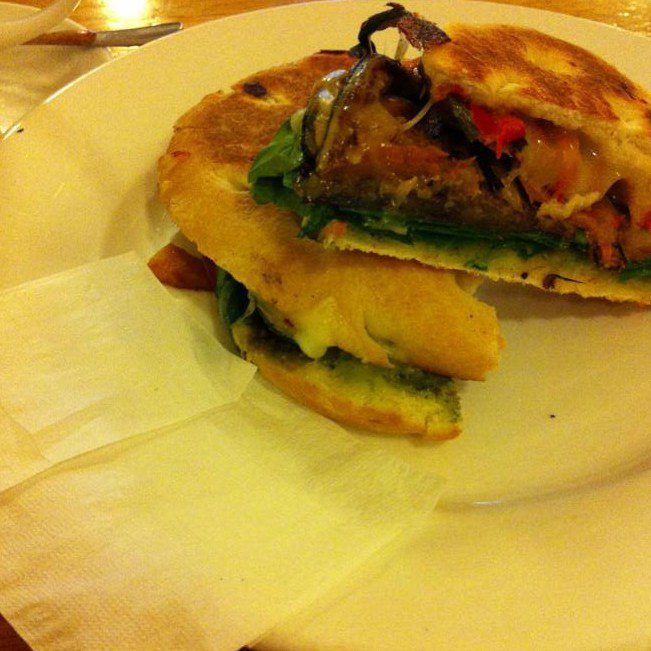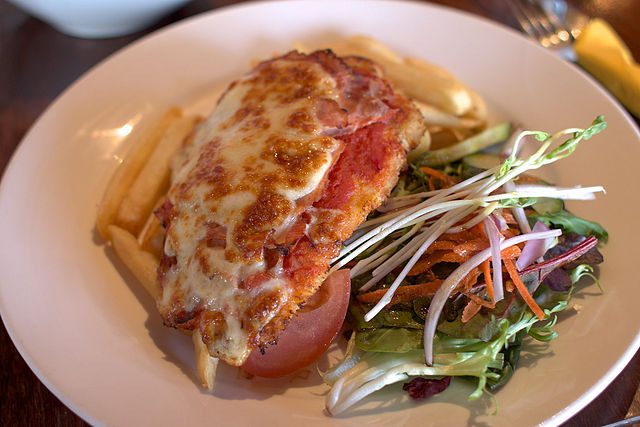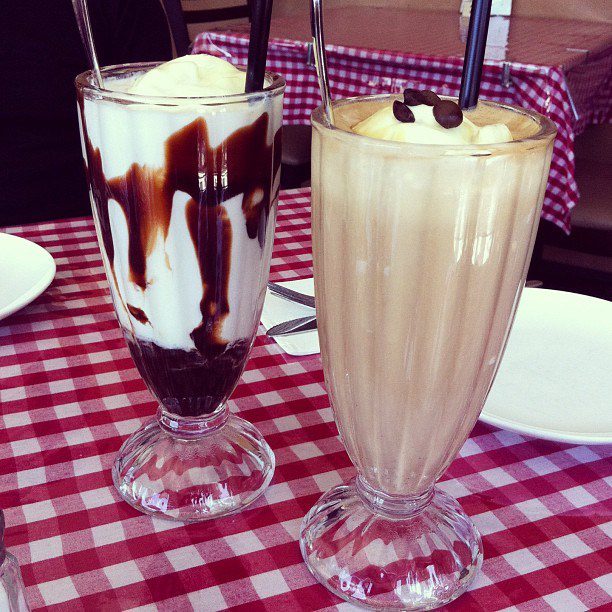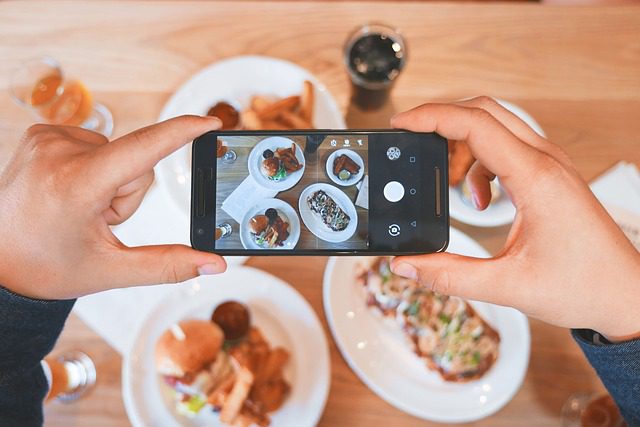Earlier this week I wrote a guide on how to speak Australian because although Americans and Australians both speak English, we speak different versions of it. Similarly, Americans and Australians equally enjoy meeting our family and friends for coffee or a meal, but eating out in Miami is very different from eating out in Melbourne. Here are some tips for eating out in Melbourne.
Melbourne has some exquisite restaurants, the kind with maître d’s with French accents and moustached men that place a fine linen napkin on your lap. I don’t go to those restaurants. I’m talking about your average cafes, pubs, and casual restaurants, the kind that are tightly squeezed in CBD laneways, the kind where you meet your friends and book club.
Service
Truth be told, dining in Melbourne is still a mystery to me. There are few common modes of operation. Some cafes and restaurants require bookings and some don’t. There’s no rhyme or reason to it. My partner and I once went into a casual burger joint in the northern suburbs and they wouldn’t seat us because we hadn’t made a reservation. Another time, I called a swanky cafe in the city to book lunch and they didn’t require it. My friend and I showed up and were seated right away. I suggest calling ahead and ask if bookings are required.
In some restaurants, you should wait to be seated while in others you can walk in and sit where you want. There isn’t always a sign to inform you. I always ask as I enter.
Eating in Melbourne, particularly in the CBD, is generally not a quiet, private affair. Many cafes and restaurants are small with tables packed closely together. Many also have long communal tables where different parties sit together. Be prepared to hear every conversation going on except yours.
Once you sit, a server may or may not appear. If they don’t appear, it’s likely that everything the restaurant offers is written on a board somewhere or you have to go to the counter and fetch your own menu. A lot of cafes and smaller restaurants require that you order at a counter. Order, pay, and you’ll receive a number for your table so the server knows where to bring the food. Even in some larger, family-style restaurants, you may have to pick up your own food when they call your number. If you get table service, you may still need to pay at the counter at the end of your meal.
Regardless of whether a server comes to your table or not, you may not be served water. Water is the melange of Australia. For those of you that are slightly less nerdy than I am, melange or “spice” is the rare and valuable fictional drug from the science fiction series Dune. In many cafes and restaurants, servers don’t bring you water. Sometimes there’s a table with bottles of water and you can grab one for your own table or sometimes there are pitchers from which you can fill and refill your glass. The water is often room temperature. Depending on the restaurant, you might be able to ask your server for water. When it runs out, you’ll have to ask for more.

Napkins come in a close second to water in scarcity. Most cafes and restaurants will give you a single napkin – or serviette, as Aussies say. For some bizarre reason, they often place the food on the napkin so it arrives to you soiled. Ask for more napkins if you need them.
Unlike in the US, servers are not walking around refilling your drinks or making sure you have everything you need. If you need something, don’t wait and expect a server to check on you. Flag someone down.
Food
Food in Melbourne is like food anywhere else. Some of it is exceptional, some of it is average, and some of it is bad. Looks are highly deceiving in Melbourne. Some crazy-looking places have great food and some elegant or trendy restaurants turn out to be average, even mediocre.
For some reason, in North America, we decided that an entrée is a main dish, but in French cuisine, the word describes a dish served before the main course or in between courses. In Australia, an entrée, or starter, comes before the main course; the word appetiser isn’t really used here. Here are some other words to know.
In Australia, a lemonade is Sprite. A “traditional lemonade” is a lemonade and even that’s not always helpful. Most cafes and restaurants don’t have this. The closest thing you might find are lemon-flavoured soft drinks manufactured by Schweppes, such as Solo, and similar drinks.
Lemon, Lime, and Bitters is divine. This is a mixed drink made with lemon cordial, lime cordial, soda water, and Angostura bitters. It is often thought of as non-alcoholic, but it has an exceedingly low alcohol content. It’s delicious and refreshing on a hot day.
Are you wondering what cordial is? Cordial is a non-alcoholic drink made by mixing concentrated juice, sugar, and water. Sometimes called squash, it’s a concentrated syrup used in beverage making. They come in flavours like lemon, lime, apple, and raspberry.
A milkshake is just flavoured milk. A thick shake has ice cream in it and is closer to what we know of as a milkshake.
Chips are potato wedges and fries, but sometimes they’re also what we know as potato chips, which are sometimes called crisps by Aussies.
Tomato sauce refers both to ketchup and the kind of tomato sauce you put on pasta. By the way, it’s pronounced to-mah-toe, not to-may-toe. Potatoes are still pronounced po-tay-toes.
Jelly is flavored gelatin, like Jell-O, not fruit preserves, which is jam.

Chicken parma sounds familiar, but the Australian version is a pub classic consisting of a really thin piece of breaded chicken (called schnitzel) topped with ham, tomato sauce (the pasta kind), and melted cheese. Unlike in the US, it’s never served with pasta. It’ served with chips (as in fries) and salad or veggies.
A typical salad is usually rocket (arugula) with a few pieces of tomatoes and maybe onions and cucumber. They’re usually pretty boring.
A burger with the lot (with everything) includes beetroot and egg.
The coffee situation
Melbourne loves to announce what an amazing coffee city it is. Melbourne doesn’t have coffee culture. It has coffee snobbery. Coffee culture doesn’t have to try so hard; it just is. There is a lot of excellent coffee in Melbourne, but there’s a lot more coffee that’s just average.
Americans that are used to extensive coffee menus and creative recipes will be disappointed. The average coffee menu in Melbourne has a familiar short list:
- short black: a single shot of espresso
- long black: a double-shot of espresso and hot water
- flat white: foamy steamed milk and espresso served in a mug
- latte: foamy steamed milk and espresso often served in a glass
- cappuccino: steamed milk and espresso with more froth than the flat white and latte
- chai latte: sometimes made with real spices and milk, but more often made with a processed, sugary powder mix and milk
- hot chocolate: chocolate powder and lukewarm milk (if you like it hot, order it extra hot)
The difference between a flat white and a latte is highly debatable. Drip coffee is extremely uncommon. Iced coffee and iced chocolate contain ice cream. Iced coffee, the kind that is coffee over ice, is also uncommon. Iced chai is also relatively unknown. Some cafes may have flavoured syrups and other coffee drinks such as affogato and Vienna coffee. You can also find Thai, Vietnamese, Greek, and Turkish coffee in those kinds of restaurants.

Some cafes have drinks that are not on the menu, such as a mocha or a dirty chai (a chai latte with espresso). If you’re after a particular coffee concoction, ask the barista about it. Some cafes and baristas are snobbish, but many are friendly and happy to make you a speciality drink.
Do and don’t
Awesome Aussie foods to try include fish and chips, kangaroo steaks, lamingtons, sticky-date pudding, and all manner of sweets, not to mention all the wonderful Mediterranean and Asian food. There is some good Mexican and Spanish restaurants. There are few other authentic Latin restaurants in Melbourne.
Aussie foods to try so you can reject: Vegemite, sausages, sausage rolls, meat pies, and Pavlova.
Aussie food to try if you’re adventurous: witchetty grubs.
If you love cocktails, like I do, proceed with caution. Spirits are very expensive in Melbourne and I can count on one hand how many good cocktails I’ve had. Beer and wine are safer bets.
Wrapping up
Just like in the US, depending on how busy the restaurant is, you may be quickly shuffled out to free the table or, if it’s slow, you may be able to linger and chat with your mates. If you didn’t pay when you ordered your meal, the server may or may not bring the bill to your table at the end. If they don’t, then go to the counter to pay. You may have to tell the cashier what you had.
In Miami, I rarely carried much cash with me, but in Melbourne, I always do. Most cafes and restaurants accept credit cards, but not all, and some have minimums or processing fees. Also, many restaurants don’t split bills. If you’re eating with friends, one person will have to pay.
An important thing to know is that you don’t need to tip. Servers here earn a normal wage and do not depend on tips. You can leave a tip if you want and I’m sure it’s appreciated, but it’s neither necessary nor expected. This is good for the server, but not so great for the customer and it’s why you won’t receive the kind of attention you’re used to back in the US.
I’ve heard a lot of American expats say that dining in Melbourne is not a pleasant experience. They find it too expensive, the food is mediocre, the restaurants are too crowded and loud, the service is poor, and let’s not even get started on the parking problem. My Australian partner dislikes eating out, but I enjoy trying new places and I love getting together with a friend over coffee or a nice meal. However, I do think that dining in Melbourne is far more inconsistent than eating out in Miami. For example, we order pizza from the shop around the corner almost every week and it’s different every single time; sometimes it’s good, sometimes it really bad. You just never really know what you’re going to get in Melbourne and that can be problematic. I’m willing to take the risk because, being fairly new to Melbourne, I’m still figuring it out and finding favourites.


Well I’m sure my time in Melbourne will be an adventure because I, like you, love to explore the food scene. Any recommendations as far as places? And I must know, how does kangaroo meat taste? lol
If cooked well, kangaroo meat is very nice. It’s a little on the heavy side, similar to venison, I suppose. I have to think about some recommended restaurants. I’m still in the “let’s try this” phase so I haven’t established any regular places that I really love.
the truth is, here in australia food is just not that important as it is for americans
Gotta disagree. Melbourne is a massive foodie city.